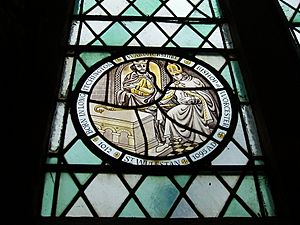Wulfstan (died 1095) facts for kids
Quick facts for kids Wulfstan |
|
|---|---|
| Bishop of Worcester | |

Stained glass depicting Wulfstan in the Church of St John in Bedwardine, St John's, Worcester
|
|
| Appointed | 1062 |
| Reign ended | 20 January 1095 |
| Predecessor | Ealdred |
| Successor | Samson |
| Other posts | Prior of Worcester |
| Orders | |
| Consecration | 8 September 1062 by Ealdred |
| Personal details | |
| Born | c. 1008 Long Itchington, Warwickshire, Kingdom of England |
| Died | 20 January 1095 (aged around 86) Worcester, Worcestershire, Kingdom of England |
| Denomination | Catholic |
| Sainthood | |
| Feast day | 19 January |
| Venerated in | |
| Canonized | 14 May 1203 by Pope Innocent III |
| Attributes | Bishop |
| Patronage | Vegetarians and dieters |
| Shrines | Worcester Cathedral (destroyed) |
Wulfstan (born around 1008 – died 20 January 1095) was an important religious leader. He served as the Bishop of Worcester from 1062 until his death in 1095. He was the last bishop from England to hold his position after the Normans took over the country. Wulfstan is honored as a saint in many Christian churches today.
Contents
Who Was Wulfstan II?
Wulfstan is sometimes called Wulfstan II. This means he was the second Bishop of Worcester named Wulfstan. It can be a bit confusing because his uncle, who was also named Wulfstan, was the second Archbishop of York with that name.
Wulfstan's Early Life and Calling
Wulfstan was born around the year 1008 in a place called Long Itchington in Warwickshire, England. His family faced difficulties and lost their land when King Cnut became king.
He was likely named after his uncle, Wulfstan II, Archbishop of York. Thanks to his uncle's help, Wulfstan studied at religious schools in Evesham and Peterborough. Later, he became a clerk in Worcester.
A Change of Heart
While working in Worcester, Wulfstan became known for his dedication and pure life. His leaders encouraged him to become a priest. In 1034, he worked at St Mary’s Church in Hawkesbury, Gloucestershire. Here, something happened that changed his life.
During his prayers, he smelled a goose cooking nearby. He felt so bad about being distracted by food that he decided to never eat meat again. From that day on, Wulfstan became a vegetarian. He was ordained as a priest in 1038 and soon joined a monastery of Benedictines in Worcester.
Becoming Bishop of Worcester
Wulfstan held important roles at the Worcester monastery, including treasurer and prior. The bishop of Worcester at the time, Ealdred, was also the Archbishop of York. The Pope asked Ealdred to give up his role as Bishop of Worcester.
Ealdred chose Wulfstan to take his place. Wulfstan became Bishop of Worcester on September 8, 1062. He was consecrated by Ealdred. Wulfstan made sure to show his loyalty to the Archbishop of Canterbury, as Worcester was part of that area.
Wulfstan After the Norman Conquest
After the Norman conquest of England in 1066, Wulfstan was the only English-born bishop who kept his position for a long time. Most other English bishops were replaced by Normans. William of Malmesbury, a historian, wrote that Wulfstan cared deeply about his diocese, which is the area a bishop oversees.
A Social Reformer
Wulfstan was a social reformer, meaning he worked to improve society. He tried to help people during the big changes after the Norman Conquest. He was strongly against the slave trade. Along with another leader named Lanfranc, Wulfstan played a key role in stopping the slave trade from Bristol.
Helping the King
In 1075, Wulfstan and the local army, called the fyrd, helped stop a rebellion against William the Conqueror. This showed his loyalty to the new Norman king.
Building and Leadership
Wulfstan started the Great Malvern Priory. He also oversaw a lot of rebuilding work on important churches. These included Worcester Cathedral, Hereford Cathedral, and Tewkesbury Abbey. He famously cried when the old Worcester Cathedral was torn down. He was sad to see a place where "so many holy and devout men have served God" disappear.
Wulfstan also helped other archbishops with their duties. For example, he assisted the Archbishops of York with consecrations, which are special religious ceremonies.
Wulfstan's Legacy and Sainthood
Wulfstan passed away on January 20, 1095, after a long illness. He was about 86 years old. Even in his final days, he continued his custom of washing the feet of his parishioners.
Soon after his death, a book about his life as a saint, called a hagiography, was written. Wulfstan was officially made a saint on May 14, 1203, by Pope Innocent III. He became known as the Patron Saint of Peasants and Vegetarians. One story says Wulfstan even cured King Harold's daughter.
Remembering Wulfstan Today
In 2008, a thousand years after Wulfstan's birth, a new stained glass window was made in his memory at St Mary the Virgin Church in Hawkesbury. The window shows parts of his life, like broken chains (representing his fight against slavery), a goose (from his vegetarian decision), and vegetables.
In 2021, St. Mary's Church installed new bells. The largest bell, weighing 600 kg, is named in honor of Wulfstan. The Church of England and the Episcopal Church remember Wulfstan with special services on January 19 each year.
Images for kids




